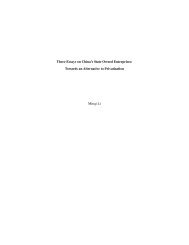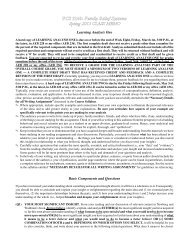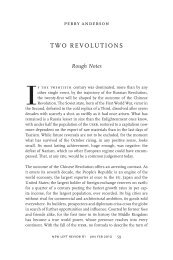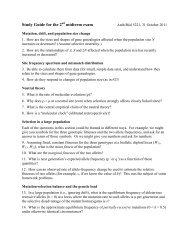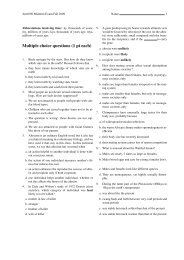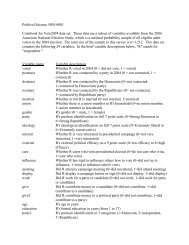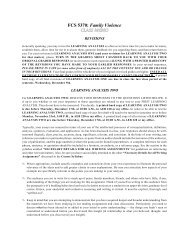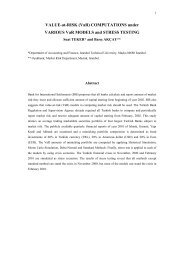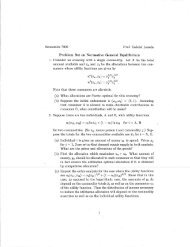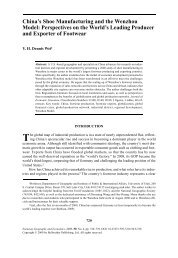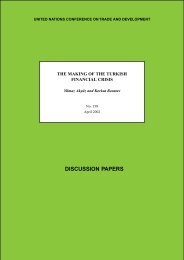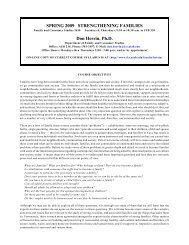Create successful ePaper yourself
Turn your PDF publications into a flip-book with our unique Google optimized e-Paper software.
ECONOMICS 7250<br />
Fall 2012<br />
Pr<strong>of</strong>essor Lozada<br />
348 O.S.H.<br />
Phone: (801) 581–7650<br />
lozada@economics.utah.edu<br />
www.economics.utah.edu/lozada<br />
CLASS MEETING TIME and PLACE: 9:30–11:00am MW, Marriott Library 1160.<br />
TEXTBOOK:<br />
Herman E. Daly and Kenneth Townsend, Valuing the Earth: Economics, Ecology,<br />
Ethics. MIT Press, 1993.<br />
GRADING: The final exam will be comprehensive, and will be worth 75 points.<br />
The other 25 points <strong>of</strong> your grade will be determined by presentations on portions<br />
<strong>of</strong> books written or edited by Herman Daly.<br />
POLICIES: (1) Incompletes will be given only for reasons <strong>of</strong> illness or a family emergency.<br />
You must supply evidence for the reason. (2) I will approve withdrawals at<br />
any time, subject to <strong>University</strong> regulations. (3) If you have a learning disability or<br />
for other reasons require special assistance in this course or during examinations,<br />
please notify me during the first week <strong>of</strong> class. (4) Cheating on exams and other<br />
forms <strong>of</strong> academic dishonesty may lead to expulsion from the class, failure <strong>of</strong> the<br />
class, or more severe penalties.<br />
TENTATIVE SCHEDULE: (* = see readings list, next two pages)<br />
8/20: Biological Mechanics & Optimal Control Theory<br />
8/22, 8/27, 8/29, 9/5, 9/10, 9/12, 9/17: Fisheries (private-property)<br />
9/19, 9/24: Fisheries (open-access)<br />
9/26: Timber<br />
10/1, 10/3, 10/15, 10/17, 10/22: Exhaustible Resources<br />
10/24: Resources & Growth (Sustainability)*<br />
10/29, 10/31, 11/5, 11/7: Entropy and Thermodynamics*<br />
11/12, 11/14, 11/19, 11/21, 11/26: Daly & Ethics*<br />
11/28, 12/3, 12/5: Methodology*<br />
Monday 12/10: Final Exam, 8:00am–10:00am<br />
1. Readings for the “Resources and Growth (Sustainability)” topic:<br />
(a) Required Readings
i. Lozada (1995), “Resource Depletion, National Income Accounting, and the<br />
Value <strong>of</strong> Optimal Dynamic Programs,” Resource and Energy Economics 17:<br />
137–154.<br />
ii. V. Kerry Smith, ed., Scarcity and Growth Reconsidered, HC103.7 .S25. Pages<br />
37 and 40–47, 61–62 by Stiglitz; pages 95–102 by Georgescu-Roegen.<br />
iii. Hanley, Shogren, and White, Ch. 2, “The Economics <strong>of</strong> Sustainable Development.”<br />
(b) Unrequired Readings<br />
i. Stefano Bartolini and Luigi Bonatti (2002), “Environmental and Social Degradation<br />
as the Engine <strong>of</strong> Economic Growth,” Ecological Economics 43/1 (November):<br />
1-16.<br />
ii. Wolfgang Buchholz, Swapan Dasgupta, and Tapan Mitra, (2005), “Intertemporal<br />
Equity and Hartwick’s Rule in an Exhaustible Resource Model,” Scandinavian<br />
Journal <strong>of</strong> Economics 107/3: 547–561.<br />
2. Readings for the “Entropy and Thermodynamics” topic:<br />
(a) Required Readings<br />
i. Herman E. Daly and Kenneth N. Townsend (1993), all <strong>of</strong> Part I.<br />
ii. Lozada, “Entropy and the Economic Process.” In Cutler J. Cleveland and<br />
Robert U. Ayres, eds., Encyclopedia <strong>of</strong> Energy, 2004, Volume 2, 471–478.<br />
Amsterdam: Elsevier. Held by the libraries <strong>of</strong> BYU and USU.<br />
(b) Unrequired Readings<br />
i. Lozada, “The Hotelling Rule for Entropy-Constrained Growth: A Synthesis<br />
<strong>of</strong> Two Schools <strong>of</strong> Thought,” working paper, 2004.<br />
ii. Frank L. Lambert, on new explanations <strong>of</strong> entropy in college chemistry textbooks:<br />
www.entropysite.com and<br />
www.entropysite.com/entropy is simple/index.html.<br />
iii. Erwin Schrödinger, Chapter 6 <strong>of</strong> What is Life? The Physical Aspect <strong>of</strong> the<br />
Living Cell and Matter (revised edition), QH331 .S3557.<br />
iv. Linus Pauling, “Schrödinger’s Contribution to Chemistry and Biology,” in<br />
C.W. Kilmister, ed., Schrödinger: Centenary Celebration <strong>of</strong> a Polymath,<br />
QC16.S265 S36 1987.<br />
v. Max F. Perutz, “Erwin Schrödinger’s What is Life? and Molecular Biology,”<br />
in C.W. Kilmister, ed., Schrödinger: Centenary Celebration <strong>of</strong> a Polymath,<br />
QC16.S265 S36 1987.<br />
2
vi. E. Gnaiger, “Negative Entropy for Living Systems: Controversy Between<br />
Nobel Laureates Schrödinger, Pauling and Perutz,” in E. Gnaiger, Frank<br />
N. Gellerich, and Markus Wyss, eds., What Is Controlling Life? 50 Years<br />
After Erwin Schrödinger’s What is Life?” Innsbruck, Austria: Innsbruck<br />
<strong>University</strong> Press, 1994, ISBN 3901249176.<br />
3. Readings for the “Daly & Ethics” topic:<br />
(a) Required Readings<br />
Herman E. Daly and Kenneth N. Townsend (1993), Valuing the Earth: Economics,<br />
Ecology, Ethics. Pages 11–47, Chapters 8, 9, 11, 12, and 16, and pages<br />
324–363.<br />
(b) Unrequired Readings<br />
Herman E. Daly and John Cobb, Jr., For the Common Good: Redirecting the<br />
Economy toward Community, the Environment, and a Sustainable Future,<br />
2nd edition, HD75.6 .D35 1994.<br />
4. Readings for the “Methodology” topic:<br />
(a) Required Readings:<br />
i. Nicholas Georgescu-Roegen (1972), The Entropy Law and the Economic Process,<br />
HB171 .G43. Pages xiii, 1–21, 330–345.<br />
(b) Unrequired Readings<br />
i. Beard and Lozada (1999), Economics, Entropy, and the Environment: The<br />
Extraordinary Economics <strong>of</strong> Nicholas Georgescu-Roegen, HB119.G43 B4 1999.<br />
Pages 20–44.<br />
ii. Peter S. Albin, Barriers and bounds to rationality : essays on economic<br />
complexity and dynamics in interactive systems, HB135 .A555 1998.<br />
iii. Peter L. Bernstein, “The Great Gift <strong>of</strong> Uncertainty,” Journal <strong>of</strong> Portfolio<br />
Management, Summer 1996, Vol. 22 Issue 4.<br />
iv. M.C. Findlay, E.E. Williams, and J.R. Thompson, “Why We All Held Our<br />
Breath When the Market Reopened,” Journal <strong>of</strong> Portfolio Management,<br />
Spring 2003, Vol. 29 Issue 3, p91–100.<br />
v. Berc Rustem and Kumaraswamy Velupillai, “Rationality, Computability, and<br />
Complexity,” Journal <strong>of</strong> Economic Dynamics and Control, Volume 14, Issue<br />
2, May 1990, Pages 419-432.<br />
vi. Alfred L. Norman and David W. Shimer, “Risk, Uncertainty, and Complexity,”<br />
Journal <strong>of</strong> Economic Dynamics and Control, Volume 18, Issue 1, January<br />
1994, Pages 231–249.<br />
3
OTHER BOOKS OF INTEREST:<br />
1. General Texts:<br />
(a) Nick Hanley, Jason F. Shogren, and Ben White, Environmental Economics<br />
in Theory and Practice, Second Edition. Palgrave Macmillan, 2007.<br />
(b) R. Quentin Grafton, Wiktor Adamowicz, Diane Dupont, Harry Nelson, Robert J.<br />
Hill, and Steven Renzetti, The Economics <strong>of</strong> The Environment and Natural<br />
Resources. Blackwell Publishing, 2004.<br />
(c) Jon Conrad and Colin W. Clark, Natural Resource Economics: Notes and<br />
Problems, HC 59. C693 1987<br />
(d) Partha S. Dasgupta and Ge<strong>of</strong>frey M. Heal, Economic Theory and Exhaustible<br />
Resources, HC 55. D37<br />
(e) John M. Hartwick and Nancy D. Olewiler, The Economics <strong>of</strong> Natural Resource<br />
Use, 2nd edition, Addison Wesley, 1998.<br />
(f) Ge<strong>of</strong>frey M. Heal, ed., The Economics <strong>of</strong> Exhaustible Resources, HC 13.2<br />
E27 1993<br />
(g) Allen V. Kneese and James L. Sweeney, Handbook <strong>of</strong> Natural Resource and<br />
Energy Economics, HB 135. H357 volume 6 parts 1–3<br />
(h) Philip Neher, Natural Resource Economics: Conservation and Exploitation,<br />
HC 59. N382<br />
(i) David W. Pearce and R. Kerry Turner, Economics <strong>of</strong> Natural Resources and<br />
the Environment, HC 79. E5 P37 1990<br />
2. Renewable Resources:<br />
Colin W. Clark, Mathematical Bioeconomics: the Optimal Management <strong>of</strong> Renewable<br />
Resources, Second Edition. QH 705. C4 1990. ISBN-10: 0471508837,<br />
ISBN-13: 978-0471508830, also ISBN-10: 0471751529, ISBN-13: 978-0471751526.<br />
Also by the same author: Mathematical Bioeconomics: The Mathematics <strong>of</strong> Conservation,<br />
Third Edition. ISBN-10: 0470372990, ISBN-13: 978-0470372999.<br />
3. Optimal Control Theory:<br />
(a) Atle Seierstad and Knut Sydsæter, Optimal Control Theory with Economic<br />
Applications, North-Holland, 1987.<br />
(b) Michael R. Caputo, Foundations <strong>of</strong> dynamic economic analysis : optimal<br />
control theory and applications, HB135 .C27 2005.<br />
(c) Alpha C. Chang, Elements <strong>of</strong> Dynamic Optimization, HB143.7 .C45 1992.<br />
(d) Morton I. Kamien and Nancy L. Schwartz, Dynamic Optimization: The Calculus<br />
<strong>of</strong> Variations and Optimal Control in Economics and Management,<br />
QA402.5 .K32.<br />
4
(e) Daniel Léonard and Ngo Van Long, Optimal Control Theory and Static Optimization<br />
in Economics, HB143.7 .L46 1992.<br />
(f) Wei-Bin Zhang, Differential Equations, Bifurcations, and Chaos in Economics,<br />
HB135 .Z536 2005.<br />
(g) Pierre N.V. Tu, Dynamical Systems: An Introduction with Applications in<br />
Economics and Biology (2nd Edition), QA614.8 .T8 1992.<br />
4. Ecological Economics<br />
(a) Nicholas Georgesçu-Roegen, The Entropy Law and the Economic Process,<br />
HB 171. G43<br />
(b) T. Randolph Beard and Gabriel A. Lozada, Economics, Entropy, and the<br />
Environment: The Extraordinary Economics <strong>of</strong> Nicholas Georgesçu-Roegen,<br />
HB119.G43 B4 1999.<br />
(c) Herman E. Daly, Ecological Economics and Sustainable Development: Selected<br />
Essays <strong>of</strong> Herman Daly, HD75.6 .V36 1993.<br />
(d) Herman E. Daly, Ecological economics and the ecology <strong>of</strong> economics : essays<br />
in criticism, HC79.E5 D3243 1999.<br />
(e) Malte Faber, Horst Niemes, and Gunter Stephan, Entropy, Environment, and<br />
Resources: An Essay in Physico-Economics, 2nd edition, HC79.E5 F2313<br />
1995.<br />
(f) Heinz D. Kurz and Neri Salvadori, “Fund-flow versus Flow-flow in Production<br />
Theory: Reflections on Georgescu-Roegen’s Contribution,” Journal <strong>of</strong><br />
Economic Behavior and Organization, 2002, vol. 1496 pp. 1–19.<br />
(g) Jeffrey S. Wicken, Evolution, Thermodynamics, and Information: Extending<br />
the Darwinian Program, QH371 .W53 1987.<br />
(h) Dugdale, J. S. (1996), Entropy and its Physical Meaning.. Bristol, Pennsylvania:<br />
Taylor & Francis Inc.<br />
(i) Ge<strong>of</strong>frey M. Heal, Valuing the Future: Economic Theory and Sustainability,<br />
HD75.6 .H416 1998.<br />
(j) Julian L. Simon, The Ultimate Resource 2, HB871 .S573 1996.<br />
5. Current Debates:<br />
(a) Running out <strong>of</strong> Resources<br />
i. Kenneth S. Deffeyes, Hubbert’s Peak : The Impending World Oil Shortage,<br />
TN870. D37 2001.<br />
ii. Paul Roberts, The End <strong>of</strong> Oil : On the Edge <strong>of</strong> a Perilous New World,<br />
HD9650.6 .R63 2004.<br />
iii. Thomas Graedel (Yale <strong>University</strong>), End <strong>of</strong> Metals, on “All Things Considered”<br />
program on National Public Radio, January 16, 2006. See<br />
http://www.npr.org/templates/story/story.php?storyId=5159755.<br />
5
(b) Are new energy sources actually net consumers <strong>of</strong> fossil fuels?<br />
i. David Pimentel and Tad W. Patzek, numerous stories on the Internet<br />
concerning bi<strong>of</strong>uels, including<br />
http://www.news.cornell.edu/stories/July05/ethanol.toocostly.ssl.html.<br />
ii. Nicholas Georgescu-Roegen, “Energy Analysis and Economic Valuation,”<br />
Southern Economic Journal, April 1979: 1023–58.<br />
(c) Miscellaneous<br />
i. Paul Hawken, Amory Lovins, and L. Hunter Lovins, Natural Capitalism:<br />
Creating the Next Industrial Revolution, HC106.82 H39 1999.<br />
ii. Partha Dasgupta, “The Population Problem: Theory and Evidence,”<br />
Journal <strong>of</strong> Economic Literature,” December 1995, 32:4.<br />
iii. Paul R. Ehrlich and Anne H. Ehrlich, The Population Explosion, HB871<br />
.E33 1990. (See also The Population Bomb, 1968.)<br />
iv. World Commission on Environment and Development, Our Common Future,<br />
HD75.6 .O97 1987. (Coined “sustainability.”)<br />
v. Gerald O. Barney and U.S. Council on Environmental Quality, The Global<br />
2000 Report to the President: Entering the Twenty-First Century. Marriott<br />
Library Government Documents call no. PREX 14.2: G51/2000.<br />
(Commissioned by Jimmy Carter.)<br />
vi. Donella Meadows, Jørgen Randers, and Dennis Meadows, Limits to Growth:<br />
the 30-Year Update,, HD75.6 .M437 2004.<br />
vii. H.S.D. Cole et al., Models <strong>of</strong> Doom: A Critique <strong>of</strong> The Limits to Growth,<br />
HC59. M59 1973.<br />
viii. Jean Drèze and Amartya Sen, Hunger and Public Action, HD9018.D44<br />
D74 1989.<br />
ix. Andrew Schotter, Free Market Economics,, HB95 .S36 1990.<br />
x. Thomas Michael Power, Lost Landscapes and Failed Economies: the<br />
Search for a Value <strong>of</strong> Place, HD9506 .U62 P69 1996.<br />
xi. Thomas M. Bonnicksen, America’s Ancient Forests: From the Ice Age to<br />
the Age <strong>of</strong> Discovery, QH104 .B635 2000.<br />
6
Course Description: Economic implications <strong>of</strong> mathematical ecology; dynamic equilibria<br />
<strong>of</strong> fishing and timber industries; depletion <strong>of</strong> nonrenewable resources; intergenerational<br />
and intragenerational equity; species’ extinction; entropy and thermodynamics;<br />
the future <strong>of</strong> economic growth; limitations <strong>of</strong> neoclassical methodology<br />
applied to dynamic systems.<br />
7




